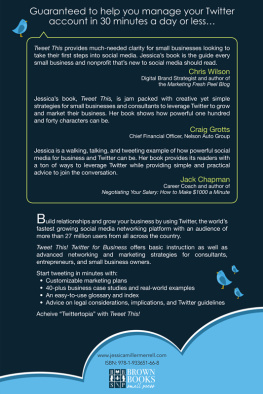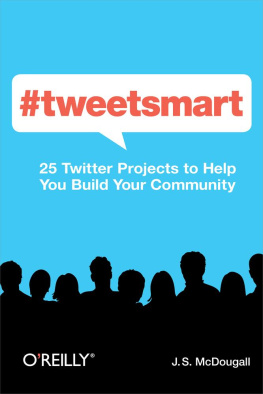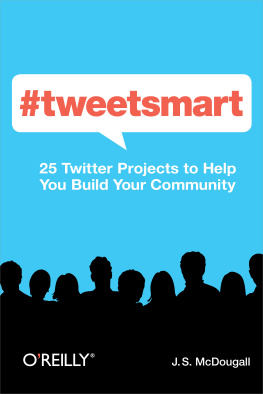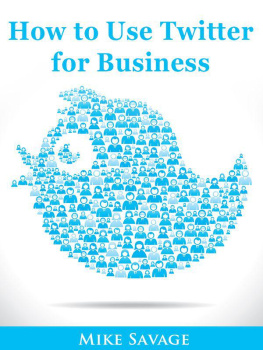CONCLUSION
Be thankful for what you have, and youll end up having more. If you concentrate on what you dont have, you will never, ever have enough.
Oprah Winfrey
According to a recent Nielsen poll, Twitter is currently the fastest growing social networking site, but it is nowhere near its saturation point. Only eighteen percent of online adults use the site, so there is plenty of room for growth. Twitter may seem complex, confusing or boring, but over time, anyone can become proficient and learn to love it.
The world is filled with educated, resourceful, innovative, and funny people. Twitter showcases their talents every day. Writing travels so much further than you could ever go using any other medium. Your view of the world will determine the type of messages you write on Twitter; hopefully, they will encourage and inspire readers to grow, rather than provoke or turn them away. Human personalities are all quite different; thus, expressing ourselves through Twitter has to be a carefully organized process.
Through the power of Twitter, you have a chance to benefit others with your talents, and there is nothing more personally rewarding than serving others. Twitter gives us an unprecedented ability to deliver newsworthy tidbits with the potential of having a positive psychological effect on possibly thousands of people. Give yourself permission to evolve. Become a philosopher. On Twitter, youll be inspired by thought- provoking speakers, meet colleagues from around the world, and gain the tools you need to navigate the constantly changing landscape of life in modern society.
In the end, what really matters is continuity. Never forget your future begins with what you do today to make tomorrow happen, so choose to be happy. Dont be so focused on getting to your future that you forget to stop and smell the roses. Enjoy the journey just as much as the destination!
Congratulations, youve done it! You are now a bona fide Twitter generalist on the road to becoming a Twitter expert. You have gained the tools necessary to build a meaningful timeline filled with humor and wisdom. Heres hoping this book has provided insight and propelled you forward with enthusiasm. You now have everything you need to have a fruitful relationship with yourself and with the Twitter community. So Tweet away, and remember: You Are What You Tweet!
-Germany Kent
APPENDIX TOOL CHEST 1: TWITTER TERMS
There are certain words and jargon native to Twitter that you may already have heard in passing. These terms and their abbreviations (in parentheses) are essential for understanding the network.
The following are common terms related to Twitter activities:
Tweet A 140-character message. Your individual Twitter post. Also known as content.
ReTweet (RT) Re-sharing or giving credit to someone elses Tweet. Sharing another users Tweets with followers, usually by using the phrase RT @username A retweet is used when a user thinks that your post is interesting or entertaining enough to share with his or her own followers. NOTE: When you resend your own Tweet, it should be hyphenated: re-tweet.
Engagement When you engage with another user, you are making conversation on Twitterverse with a string of responses and exchanges. Engagement is important in keeping Twitter followers because it shows that you are human and are capable of having meaningful online connections.
Feed The stream of Tweets you see on your homepage. Updates or Tweets that are constantly being updated. They are usually arranged in chronological order, with the most recently updated ones at the top for easier viewing.
Emoji Funny and or expressive cartoons and pictures that can be included with your Tweets.
Handle Your username.
Home Page consists of a feed of Tweets of accounts you follow; your own profile page and presents a feed of your own Tweets.
Mentions/@ Reply A Twitter update that contains @username anywhere in the body of the Tweet. Its a way to conduct discussions with other users in a public realm.
Direct Message or DM A private Twitter message sent via Twitter between people who follow each other. You can decide whether to accept a Direct Message from any Twitter user, or only from users you are following. You can only send a DM to somebody who is following you. The limit for DMs is still under 140 characters.
Hashtag (#) A way to denote a topic of conversation or participate in a larger group of linked Tweets. A hash tag is a discovery tool that allows others to find your Tweets, based on topics. You can also click on a hash tag to see all the Tweets that mention it in real time even from people you dont follow. A way to categorize Tweets around a particular topic.
FOLLOW A user can follow another individual or organization by clicking the Follow button on the persons or organizations page.
FOLLOWER A Twitter user who subscribes to follow another user. A follower is a Twitter user who has subscribed to your account so he or she can see all your posts and updates on your own page.
UN-FOLLOW Un-follow happens when one of your followers decides he or she doesnt want to be updated with your posts anymore and gets out of your network.
Tweet-and-delete Posting a message and retracting it later.
TWITTER SYNONYMS
Twitterverse, Twitter Nation, Twitter World, Twittersphere, Twitternology, Twittequette, Twitterbird
APPENDIX TOOL CHEST 2: TWITTER RESOURCES
The following is a list of Twitter services that improve your efficiency on the site. They can aid you in creating and scheduling your Tweets. Many have tools that help you track the performance of your social marketing efforts on Twitter. There are a slew of services available to help you manage your Twitter account.
Most of these resources can save you a ton of time:
TweetReach
Tweepi.com
Topsy
Hootsuite
Twellow
Wefollow
SocialOomph
Twitter.com
Buffer
Feedly
TweetDeck
Summify
NOTES
BOOKS
Dweck. Carol S. Mindset: The New Psychology of Success; New York: Random House, 2006.
Cloud, Henry. Ph.D., and Townsend, John, Ph.D. Boundaries: When to Say Yes, How to Say No, to TakeControl of Your Life, Michigan: Zondervan, 1992.
Gilbert, Daniel. Stumbling on Happiness; New York: AA Knopf, 2006.
Judith Orloff, Positive Energy, Harmony Books, 2004.
Canfield, Jack. Mark Victor Hansen and Les Hewitt, ThePower of Focus; Deerfield Beach, Florida: Health Communications, Inc., 2000.
Covey, Stephen. The Seven Habits of Highly EffectivePeople; New York: Simon & Schuster, 1990.
Dyer, Wayne W., Youll See It When You Believe It; New York: Harper Collins, 1989.
Fortgang, Laura Berman. Living Your Best Life; New York: Jeremy P. Tarcher/Putnam, 2001.
Mason, John. You Can Do It Even if Others Say You Cant. Michigan: Revell, 2003
Jenkins, Jovita. Get Out Of Your Own Way; Culver City: Ajides Publishing, 2004.
Harrell, Keith. Attitude is Everything; New York: Harper Collins, 2000.
Jeffers, Susan. Feel The Fear and Do It Anyway; New York: Ballantine Books, 1987.








